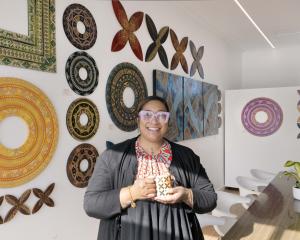BY ROBYN MAREE PICKENS

‘‘Exquisite Corpse’’
(Olga)
Otherwise known as ‘‘exquisite cadaver’’, exquisite corpse is a well-known exercise in which each participant creates a drawing that responds to the indicative lines or forms that cross the crease in the paper preceding it.
The idea is to draw from these cues without seeing the entire image, thereby producing a collective work from three individual creative impulses. Despite the familiarity of the practice, which originated with the Surrealists, the outcomes attest to its endurance.
Curated by Nicola Hansby, as part of the Dunedin Fringe Festival, this outing of the exquisite corpse has resulted in a gallery full of framed tripartite drawings rendered primarily in black and white.
The participating artists are predominantly Dunedin-based, and there are many curious and wonderfully strange configurations.
One such work presents the dented head of a bird that appears simultaneously fossilised and animate in the top section, a cloud-like tangle of organisms emerging from some yet-to-be-discovered terrestrial-marine compound in the middle, and, naturally enough, a naturalistically drawn hand, fingers poised mid-curl in the bottom section.
This work encompasses a multispecies realm of bird life, organisms (perhaps coral) and the human. In other works, the central section comprises torso that are variously effluvial with claw-like fingers, tentacular and floral.
This exhibition includes contributions by emerging and established artists, yet the authors of each work are not specifically attributed to a particular work. The collaborative spirit is refreshing. All proceeds go to Chat Bus.

‘‘Diamond Mine’’, Marion Wassenaar
(RDS Gallery)
The levels of mutability informing the conceptual and physical properties of Marion Wassenaar’s ‘‘Diamond Mine’’ exhibition are quite literally cosmic.
On first view, the 15 framed works on paper appear to be black drawings or prints of centrally situated constellations, spider webs, stylised suns, or the centres of flowers. That is, if the viewer fails to observe the first work, an installation comprising a black doily arranged on an ironing board in the gallery window (Diamond Dust I).
Typically white and soft, this doily is black and seems fragile, which is accurate, as it has been carbonised. In a similar reversal, the patterns of doilies - with their centrally radiating compositions and fractal-like wellbeing - seem diminished and bereft.
The ecological orientation of these works becomes perceptible with the knowledge that carbon compounds form the basis of all life on earth. But the release of stored carbon through the burning of coal and deforestation leads to excessive carbon (CO2) in the atmosphere and to climate disorder.
One of allotropes, or structural forms, of carbon manifest as diamonds, which are the hardest organic material known, and capable of withstanding intense heat and pressure. Heat circles back to carbonisation and global heating (warming), while pressure refers to the process of putting the carbonised, crocheted doilies through the printing press, and analogous with heat, to the pressure of a carbon-saturated atmosphere.
‘‘Diamond mine’’ references the doilies Wassenaar crocheted, and capitalist extraction.

‘‘GLOSSY LEAF kiss’’, Louie Zalk-Neale and Connor Fitzgerald
(Blue Oyster)
‘‘Glossy Leaf kiss’’ is animated by the wairua of Louie Zalk-Neale and Connor Fitzgerald’s engagements with the bark of trees, the flow of streams and the littoral between ocean and coast.
The presence of these encounters lingers in plaited ti kouka fibres, ceramic and cast bronze works, ink drawings, video, and expands to the space itself. This wairua was enhanced by an opening performance involving ritual, poetry, movement, and the tying of several stones held by participants to a long woven cord suspended from the ceiling.
The artefacts of ritual and the relinquished stones remain in the gallery for the duration of the exhibition and anchor the intimacy of the experience.
Zalk-Neale and Fitzgerald’s sustained encounters with the rest of nature are inflected by the artists’ expressions of fluid gender and sexuality that travel beyond binaries.
In many respects ‘‘GLOSSY LEAF kiss’’ is a celebration of confluences between queerness and the more-than-human world. Their experiences with nature and the resultant artworks manifest a type of sacred queerness that honours the esteemed relationship between queer people and the life force of the earth in less consumerist cultures.
The exhibition is also an experience of earth-based time: of human beings remembering an older rhythm. One that involved the press of hands against clay, the preparation and twisting of fibre to make rope, and the impulse to arrange shells, stones, leaves, and feathers in patterns.












